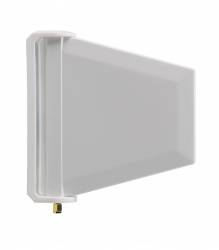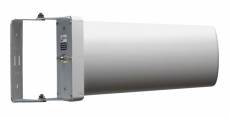GSM Antennas
- further categoriesThe first thing that comes to mind when people think of GSM antennas is mobile phones, and not without reason, as these are considered to be the primary application for these types of antennas. However, it can be used not only for mobile communication but also for other wireless solutions, so you can find GSM antennas for cash registers as well as for cars. Read more...
• Frequency: 450 MHz, 860-960 MHz and 1800 MHz
• Gain: 0- 5 dBi
• Impedance: 50 Ohms
• Mounting hole: Ø 13 mm
• Connector: 4.2 meter RG-58 cable with BNC-male
• To deliver with other connector please ask us!
• Frequency: 824-960 / 1710-1990 MHz
• Gain: 0- 5 dBi
• Impedance: 50 Ohms
• Magnetic mount diamater: Ø 8 cm
• Whip length: 32.5 cm
• Connector: 5 meter RG-58 cable with BNC-male
• To deliver with other connector please ask us!
• Type: log-per
• Frequency range: 890–960 MHz (GSM 900)
• Impedance: 50Ω
• Polarisation: vertical
• Gain: 6 dBi @ 900 MHz
• VSWR: < 1,5:1
• Maximum input power: 6 Watts
• Type: log-per
• Frequency range: 890–960 MHz; 1710–1920 MHz (GSM 900/1800)
• Impedance: 50Ω
• Polarisation: vertical
• Gain: 4 dBi @ 900 MHz; 5 dBi @ 1800 MHz
• VSWR: < 2:1
• Maximum input power: 15 Watts
• Type: log-per
• Frequency range: 890–960 MHz; 1710–2170 MHz (GSM 900/1800, UMTS)
• Impedance: 50Ω
• Polarisation: vertical
• Gain: 4 dBi
• VSWR: < 1,7:1
• Maximum input power: 15 Watts
• Type: log-per
• Frequency range: 790–960 MHz; 1710–2700 MHz (GSM 900/1800, UMTS, LTE)
• Impedance: 50Ω
• Polarisation: vertical
• Gain: 4 dBi
• VSWR: < 1,7:1
• Maximum input power: 15 Watts
• Type: yagi
• Frequency range: 1710-1990 MHz
• Impedance: 50Ω
• Radiation angle: < 45°
• Polarisation: vertical
• Gain: 11 dBi @ 1850 MHz
• VSWR: < 1,5:1
• Maximum input power: 6 Watts
• Type: yagi
• Frequency range: 1920-2170 MHz
• Impedance: 50Ω
• Polarisation: vertical
• Gain: 10,5 dBi
• VSWR: < 1,5:1
• Maximum input power: 25 Watts
• Type: log-per
• Frequency range / Gain:
430–480 MHz; max. 8,5 dBi
790–960 MHz; max. 11,3 dBi
1710–2700 MHz; max. 10 dBi
• Impedance: 50Ω
• Radiation angle: 60°
• Polarisation: vertical
• VSWR: < 2:1
• Maximum input power: 10 Watts
• Type: log-per
• Frequency range / Gain:
690–960 MHz; max. 13 dBi
1710-2185 MHz; max. 12 dBi
2500–2700 MHz; max. 10,9 dBi
• Impedance: 50Ω
• Radiation angle: 60°
• Polarisation: vertical
• VSWR: < 2,2:1
• Maximum input power: 10 Watts
• Type: log-per
• Frequency range / Gain:
790–960 MHz; max. 11,5 dBi
1710-2185 MHz; max. 11 dBi
2500–2700 MHz; max. 12 dBi
• Impedance: 50Ω
• Radiation angle: 60°
• Polarisation: vertical
• VSWR: < 2:1
• Maximum input power: 10 Watts
• Type: log-per
• Frequency range / Gain:
790–960 MHz; max. 11,5 dBi
1710-2700 MHz; max. 12 dBi
• Impedance: 50Ω
• Radiation angle: 60°
• Polarisation: vertical
• VSWR: < 2:1
• Maximum input power: 10 Watts
What does the term GSM antenna mean?
GSM (Global System for Mobile) antennas are used to transmit signals at 850, 900, 1800, 1900 MHz. Their most important role is undoubtedly in mobile communications, not only in the mobile devices themselves, but also in cell towers, providing the necessary connection between two mobile devices. Adigital GSM technology emerged in the 1990s and was for a long time referred to as 2G. Nowadays, following continuous development, it is available in 3G, 4G and 5G, enabling more and more services.
Where are GSM antennas used?
In addition to the above, GSM antennas can also be found in laptops, netbooks or other USB devices, in which case they are not used for communication but only for data transmission. There are also solutions to boost the signal of mobile phones in areas with poor coverage, in mountainous - valley areas. With these devices, we may be able to connect to remote cell towers and boost their signals for better use of our mobile phone. Similarly, wireless modems also use technology to boost the signal strength received and transmitted by the modem.
Passive devices, which means that they do not require any power to operate, but simply need to be connected to the device whose performance we want to improve.
Cash register GSM antenna
The cash register GSM antenna is available in both a magnetic and a fixed, retractable design and can be used not only for cash registers but also for other GSM devices. The magnetically attached model is available with a 5 meter cable, the retractable version with a 4.2 meter RG-58 cable, both with 50 Ohm output RF impedance. They are available with BNC connectors, which can be purchased with other connectors on request at extra cost
GSM base antenna
The Carant GSM base antenna for Wi-fi systems is a stable and reliable solution for signal amplification and transmission, especially for larger buildings. They can be omnidirectional antennas, which can transmit horizontally in all directions evenly. Directional types can transmit the signal in a specific direction.
Car antenna
Car antennas are also available in magnetic and retractable designs. The latter requires a hole to be drilled in the roof or door of the vehicle to fix the antenna and to insert the cable. They can basically be made of two types of material: steel types are flexible and more resistant to external influences, while fibreglass types are much more fragile.
What should you look out for when buying?
To use a GSM antenna, it must support the frequency used by your service provider or other device. Modern models are typically multi-frequency, multi-band models, for which relevant information can be found in the relevant product specification. Another important parameter is the gain in decibels (dBi), which refers to the signal gain provided by the antenna - higher dBi means higher signal strength.
We offer a selection of quality pieces with stable performance, whatever the purpose of your purchase. Knowing your needs and the required technical parameters, you can easily find the GSM antenna type that best suits your purposes.









